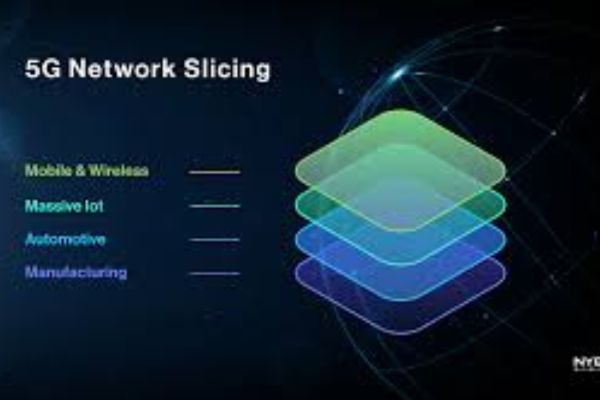The global network slicing market size is evaluated at USD 1.95 billion in 2025 to predicted to surpass around USD 50.99 billion by 2034, at a CAGR of 43.68% from 2025 to 2034
In today’s hyper-connected world, businesses are undergoing rapid digital transformation, and the demand for agile, secure, and high-performance connectivity has become critical to success. As enterprises embrace new technologies like automation, AI, IoT, and edge computing, they require network infrastructures that can meet diverse and often conflicting performance needs. This is where network slicing is emerging as a cornerstone of modern enterprise connectivity.
What is Network Slicing? A Business Perspective
Network slicing is a 5G and 6G-enabled capability that allows multiple virtual networks to operate on a shared physical infrastructure. Each of these “slices” is isolated and programmable, enabling service providers to deliver customized performance, whether in terms of latency, bandwidth, reliability, or security, tailored to specific enterprise use cases. For example, a smart factory can dedicate one slice for real-time robotic operations requiring ultra-low latency and another for administrative data transfer with less stringent requirements. This separation ensures mission-critical applications are not affected by congestion or performance degradation in other parts of the network.
Strategic Business Value: SLAs, Differentiation, and Control
The implications of network slicing go far beyond operational flexibility. For C-level executives and IT strategists, slicing enables the ability to guarantee service-level agreements for individual business functions or even for specific clients and partners. In sectors such as healthcare, finance, logistics, and manufacturing, where regulatory compliance, uptime, and data integrity are non-negotiable, this level of network customization offers a competitive edge. Enterprises are now seeing network slicing not merely as a telecom capability but as a business enabler—supporting strategic goals such as automation, remote operations, and digital service delivery.
AI and Automation: Intelligent Orchestration for Dynamic Demands
As the adoption of network slicing scales, one of the most powerful trends shaping its evolution is the integration of artificial intelligence and automation. Enterprises managing complex IT environments are seeking ways to reduce manual intervention and improve response times. AI-driven orchestration tools can dynamically allocate slices, monitor performance, and adapt to fluctuating demand across business units in real time. This shift from static to intelligent network management empowers businesses to scale services efficiently while ensuring network resources are allocated where and when they are needed most.
Monetization and Business Models: Moving from CapEx to OpEx
In parallel, monetization models around network slicing are evolving, offering new revenue streams and business models. Telecom providers are exploring slicing-as-a-service offerings, where enterprises pay for premium network performance based on application or usage tier. For enterprise leaders, this opens up opportunities to shift network costs from capital expenditure to operational expenditure, aligning network investment directly with business value creation. Companies are now in a position to treat connectivity not as a fixed cost, but as a variable resource tied to customer experience, productivity, or output.
Compliance and Governance: Meeting the Regulatory Challenge
However, with these benefits come new responsibilities, especially concerning compliance and governance. As network slicing enables multiple tenants and applications to run independently on the same infrastructure, concerns around data isolation, security policies, and regulatory jurisdiction have intensified. Enterprises operating across borders must ensure that each network slice aligns with regional compliance standards, such as GDPR or HIPAA. Security must also be managed at the slice level, with encryption, monitoring, and access controls tailored to the sensitivity of the data or process being served. Industry leaders are increasingly partnering with providers who offer transparent, auditable, and standards-based slicing implementations to meet these evolving demands.
Integration and Interoperability: Aligning with Existing IT Landscapes
The ability to integrate network slicing into existing enterprise architectures is also a topic of rising interest. Companies are evaluating how slicing can coexist with current SD-WAN deployments, cloud platforms, and legacy infrastructure. With the emergence of open APIs and standards-driven orchestration frameworks, many enterprises are beginning to embed slicing logic directly into their enterprise applications and IT workflows. This enables dynamic reconfiguration of network behavior based on the needs of business-critical processes, customer service platforms, or data-intensive analytics engines.
Regional Insights: Market Dynamics by Geography
Network slicing adoption varies widely across regions based on infrastructure maturity, regulatory frameworks, and industry readiness. North America is currently leading commercial deployments, driven by aggressive 5G rollout strategies, strong private network adoption, and enterprise readiness across manufacturing and logistics sectors. The U.S. in particular is seeing strong demand in smart manufacturing, autonomous vehicles, and military-grade secure communications.
Europe is rapidly catching up, fueled by coordinated efforts around 5G and industrial innovation, especially in Germany, the UK, and Nordic countries. European enterprises benefit from a harmonized regulatory approach and are focused on using slicing for smart cities, public health infrastructure, and energy grid modernization.
Asia-Pacific is witnessing some of the fastest growth, led by countries like China, Japan, and South Korea, where government-backed 5G investments have fueled advanced slicing trials. China is already leveraging network slicing at scale for verticals such as port automation, telemedicine, and AI-driven surveillance. Meanwhile, India’s enterprise segment is awakening to slicing possibilities in banking, telecom, and agriculture, especially as local telcos explore private 5G deployments in industrial zones.
Latin America and the Middle East are at an earlier stage but show strong interest, particularly in oil and gas, government security, and smart transportation projects. The global adoption map highlights a clear pattern: countries with strong digital infrastructure and proactive regulatory frameworks are moving faster to operationalize slicing at the enterprise level.
Country-Level Demand and Voice Specification
Different countries are placing emphasis on distinct use cases and voice/data performance requirements. For instance, Germany is setting stringent quality-of-service standards for industrial automation, while Japan focuses on ultra-low latency slices for smart city integration. The U.S. is heavily investing in secure network slices for government and defense agencies, while South Korea’s telecom sector is optimizing slicing for high-definition media streaming and immersive VR environments.
India, a rising digital hub, is shaping slicing strategies around voice call quality, bandwidth differentiation for financial services, and agricultural IoT. Regulatory frameworks in these countries are also influencing how voice and data are prioritized within slices, ensuring reliability for emergency communication, healthcare systems, and real-time collaboration tools.
Key Players Driving the Network Slicing Ecosystem
The global network slicing ecosystem is being driven by a mix of telecom operators, network infrastructure providers, and software vendors. Among the top telecom operators advancing slicing are AT&T, Verizon, China Mobile, SK Telecom, Deutsche Telekom, NTT Docomo, and Reliance Jio, each piloting or deploying slices across enterprise use cases.
On the vendor side, Ericsson, Nokia, Huawei, and Samsung Networks are leading the charge in delivering end-to-end slicing solutions, including RAN, core, and orchestration layers. Cloud players like AWS, Google Cloud, and Microsoft Azure are also entering the slicing space, offering APIs and services to integrate slices with cloud-native applications. Emerging startups such as Casa Systems, Affirmed Networks (Microsoft), and Mavenir are delivering slice-aware software stacks and automation platforms tailored for enterprise and private 5G needs.
Together, these players are forming powerful collaborations that span infrastructure, application enablement, and service delivery, creating a robust foundation for enterprise-grade slicing worldwide.
Network Slicing Market Top Companies
- Samsung
- Intel Corporation
- Telefonaktiebolaget LM Ericsson
- Nanjing ZTE Software Co. Ltd.
- VMware, Inc.
- Huawei Technologies
- Amdocs, Inc.
- Nokia Corporation
- Mavenir Systems, Inc.
- Affirmed Networks
- Tambora Systems Ltd.
The Future of Enterprise Connectivity
Looking ahead, network slicing is expected to play a pivotal role in enabling the next wave of innovation across industries. As use cases expand—from smart cities to precision agriculture, from immersive retail to predictive maintenance—the ability to provision and manage custom connectivity on demand will become a strategic differentiator. Enterprises that invest now in understanding and piloting slicing technology will be better positioned to adapt to future disruptions and capitalize on emerging opportunities.
The Full Study is Readily Available | Download the Sample Pages of this Report@ https://www.precedenceresearch.com/sample/6150

















